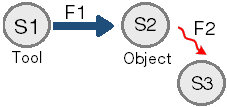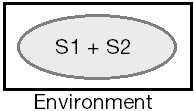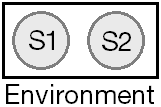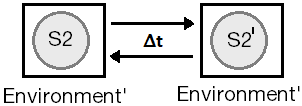Example
to reduce excessive frictional wear between two metal objects, a lubricant is introduced.

TOOL = metal object 1
F1 = create friction
OBJECT = metal object 2
S3 = lubrificant
Example
to avoid the contact between two metal object it s possible to polarize it to create a magnetic field that avoid the collision

TOOL = magnet
F1 = attract
OBJECT = metal object
F2 = opposite magnetic field
Example
when cooking it is possible to forget the ladle dipped in boiling water and consequent risk of burns; a solution to avoid getting burned is to make the wooden ladle
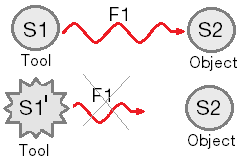
TOOL S1 = metal ladle
F1 = scald
OBJECT = user
TOOL S1' = wooden ladle
Example
to reduce or remove noise of a fan it s possible to introduce another noise out of phase by 180° degree

TOOL = fan
F1 = make noise
OBJECT = environment
F2 = opposite noise
Example
in vacuum cleaners there is a risk that if the debris are too heavy/big they will not be sucked up, to avoid the problem the debris must be reduced in size so that the suction force is strong enough; for example bumping debris into a brush

TOOL = vacuum cleaner
F1 = aspire
OBJECT = debris
S2 = smaller debris
Example
in certain post operation which immobilization of a limb with a brace is required, there is the risk of muscle atrophy, to avoid it the limb is subjected to impulses that cause the activation of tendons leaving the limb stationary

TOOL = brace
F1 = atrophies
OBJECT = muscles
F2 = give impulse
Example
replace the action of an operator to lock two pipes by welding, with a bolted flange lock. More suitable if maintenance is required on the pipes.
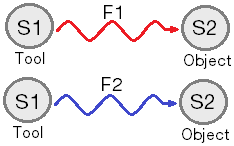
TOOL = operator
F1 = weld
OBJECT = ducts
F2 = locks with bolted flange
Example
ABS in cars is a system that at every braking checks it is not excessive, in case there s an automatic activation to avoid the wheele locking
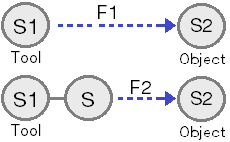
TOOL = breaking circuit
F1 = break
OBJECT = wheels
S = ABS system
F2 = controlled break
Example
a second cam called conjugate is introduced into the cam mechanisms, to generate forces on the follower that avoid disengagement with the main cam

TOOL = principal cam
F1 = control movement
OBJECT = follower
S = conjugate cam
F2 = avoid disengagement
Example
to avoid overheating of a tool it is possible to introduce an identical one and set the system so that the two tools work alternately

TOOL = tool 1
F1 = work
OBJECT = object
S = tool 2 (= tool 1)
F2 = halves the work
Example
in motorcycle racing it is advisable to use the engine so that generates as much torque as possible, however this increases the high side risk. Therefore it is calibrated in such a way as to cut the torque just enough to reduce this risk

TOOL = engine
F1+F = trasmits excessive power
OBJECT = vehicle
F1 = trasmit right amount of power (no harmful)
Example
to increase the slip speed of skis, wax can be applied to the part of the ski in contact with the snow

TOOL = skis
F1 = slip
OBJECT = snow
S3 = wax
Example
in farms where there is a need to wet crops with water, the sprinklers are generally long-range canes that move the jet by rotating on themselves; to wet neighboring crops, a wand was introduced that hits the jet of water, slowing down its speed, shortening the jet range

TOOL = water jet
F1 = wet
OBJECT = crops
F2 = hit with mechanical wand
Example
to reduce the opening/closing time of the carburetion valves, vehicles have switched from mechanical to electronic control of injectors
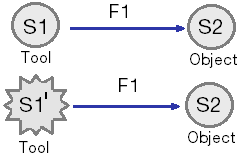
TOOL = mechanical control
F1 = open / close
OBJECT = carburetion valves
TOOL S1' = electronic control
Example
to improve the cooling of an engine and increase its performance from a thermodynamic point of view, in addition to the cooling given by natural air, a water cooling circuit has been added

TOOL = natural air
F1 = cools
OBJECT = engine
F2 = increase cooling (with water cooling circuit)
Example
to facilitate nail striking with the hammer, a flat head has been added to the nail end

TOOL = hammer
F1 = strik
OBJECT = nail
S2 = nail with flat head
Example
in the workshops to facilitate the user of a tool to position it on the wall, it is possible to equipe the wall with a magnetic field to facilitate positioning

TOOL = user
F1 = place on the wall
OBJECT = tools
F2 = attractive magnetic field
Example
the movement of the trains on the ground takes place thanks to the contact between rails and tracks, to increase the speed, the contact has been replaced with magnetic levitation
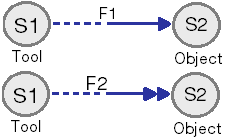
TOOL = train
F1 = move by rails and tracks (friction)
OBJECT = ground
F2 = move by magnetic levitation
Example
in manual wood cutting to exert more force a punch is introduced between the hammer and the log, to concentrate and maximize the force of the blow

TOOL = hammer
F1 = cut
OBJECT = log of wood
S = punch
Example
in demolitions with explosions, additional micro-charges are introduced in addition to control the fall direction of the building

TOOL = explosive charge
F1 = demolish
OBJECT = building
S = micro explosives charges
F2 = control the fall
Example
to create colored figures, the printers has been equipped with a second multi-color cartridge which alternates with the black one during operation

TOOL = black cartridge
F1 = color in black and white
OBJECT = multi colored paper
S = coloured cartridge
F2 = color
Example
in industries that produce sweets with an outer sugar layer, to avoid sugar waste, the sweets are first rolled in sugar and then shaken to remove the excess that is recovered
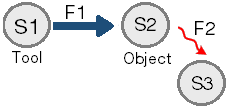
TOOL = sweets
F1 = rolled in sugar
OBJECT = sweet with outer sugar layer
S3 = recovered sugar
F2 = shake to remove sugar excess
Example
biological samples such as cells, bacteria, animal or plant tissues, are studied under a microscope, but the details are difficult to observe; it is possible to introduce a chemical coloring agent in them to enhance the structural contours of the cells.


S1 = cells
ENV = microscope structure
S2 = chemical colorant agent
S1+S2 = cells mixed with colorant agent (easily detectable)
P.S. ENV stay unaltered
Example
to measure frictional wear of a rotating metal disc in contact with another metal object when these works in an oil bath, is possible introducing a luminophore substance into the oil. Friction causes detachment of metal particles which will change the brightness of the oil.


S1 = metal objects in contact
ENV = oil
S2 = luminophore agent
ENV+S2 = oil and luminophore agent
P.S. S1 stay unaltered
Example
to measure the amplitude of oscillation of a pendulum, it is possible to take a sequence of images during the movement. By superimposing them it will be possible to notice the maximum excursion, select the corresponding photo and measure directly on that. Measurement is possible because the image is static.

S2 = photos of the pendulum
P.S. during the time variation S2 stay unaltered
Example
to study the internal stresses of a beam it is possible to reconstruct the model through a FEM software and see how they vary changing the applied loads
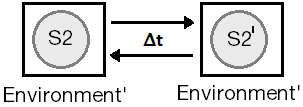
S2 = virtual model of the beam
ENV' = software environment
S2' = stressed virtual model
P.S. during the time variation the ENV stay unaltered, but S2 can change
Example
to count a large amount of coins present in a container, if they are all of the same size, it is possible to weigh just one and then weigh them all together. The number of coins will be given by the total weight divided by the unit weight.

S1 = set of coin
ENV = container
S2 = single coin
S3 = single coin
S4 = single coin
P.S.after the focus, S1 become the environment of S2,S3...
Example
to measure the volume of an object it is possible to introduce it into a container with water and measure the rise of the water surface

S1 = object
ENV = water
ENV' = (raised) water
Example
to measure the loss of vision, optometrists constrain the eye to always look at the same image, putting it more and more in focus by varying the distance between two lenses placed between the eye and the image. When the patient sees the image clearly, it is possible to quantify the loss of vision as it is proportional to the distance between the lenses.

ENV = eye + image
S1 = nothing
S2 = lens
S3 =lens
P.S. environment never change
Example
among the reverse engineering techniques there are probes that reconstruct the model of an object by defining a cloud of points in space. Thanks to a sensor they recognize if the point belongs to the object or not, verifying that the probe has come into contact or not with the object itself.
Example
in wind instruments there is a correlation between the size of a hole, the flow of air and the sound produced; it is therefore possible to identify the size of a hole thanks to the sound that the instrument produces under known flow conditions.
Example
in gases there is a correlation between temperature and pressure simplified in the ideal gas law. Therefore, to measure the pressure variation, if it cannot be measured directly, it is sufficient to know the temperature variation.
Example
thermocouples are sensors for measuring changes in temperature. They take advantage of the seeback effect, therefore a potential difference is created at the two sensor poles given by the temperature difference to which the poles are subjected. The two deltas are proportional, so it is possible to go back from the voltage to the temperature
Example
in the medical field for the measurement of glucose in the blood there are photometric tests which use a test strip that reacts with a drop of blood and changes color depending on the amount of glucose contained.
Example
to wet crops far from the water source, so increase the distance of a water jet, a conical nozzle can be attacked to the outlet of a barrel.

TOOL = barrel
F1 = wet
OBJECT = distant crops
S3 = conical nozzle
Example
to increase the friction that the asphalt generates on the tires, in drag races, a special glue is placed on the asphalt to create an additive friction force

TOOL = wheels
F1 = generate friction
OBJECT = asphalt
F2 = increase the friction
Example
to deflect the destructive effect of an earthquake on a building, it is possible to introduce elastomeric insulators into the foundations. To reduce the horizontal stiffness and move the building's oscillation frequency away from that of the earthquake.

TOOL = earth
F1 = make vibrate
OBJECT = building
S3 = elastomeric insulator
Example
to avoid the attraction of a piece of iron from a magnet, it is possible to heat it and bring it to a temperature of 770° (corresponding at the iron's Curie point) to make it lose its magnetic properties.

TOOL = magnet
F1 = attract
OBJECT = piece of iron
F2 = increase temperature
